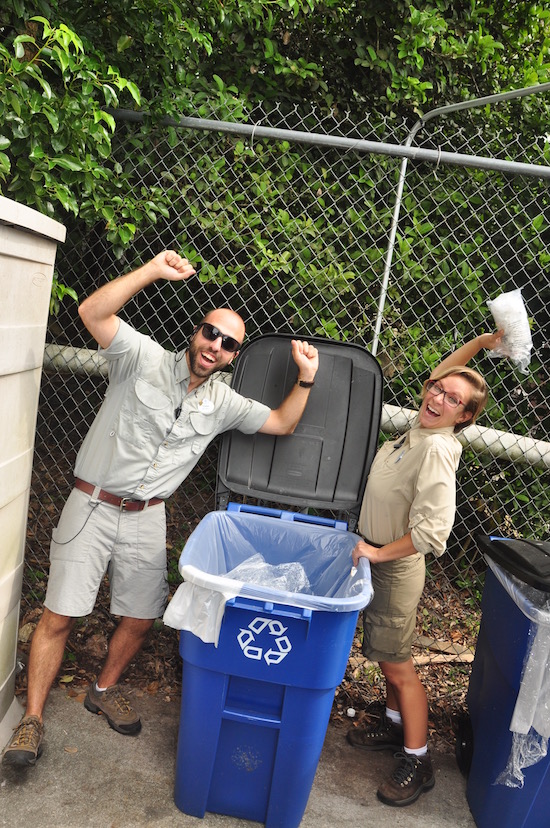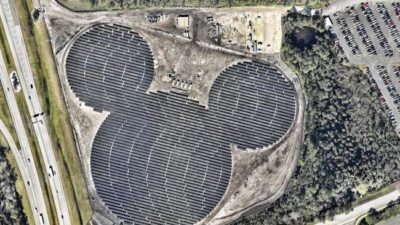
When Walt was designing, and building Disneyland®, he had conservation in mind. About two-thirds of Disneyland’s original storm drains flow into interconnected canals that feed Rivers of America, Storybook Land, Castle Moat and Jungle Cruise. The value of conservation at the Disney company has carried over to every park and resort Disney owns as well as creating educational and outreach programs around the world through the Disney Conservation fund. The Disney company as a whole works in the area of conservation in so many arms of the business, I will only touch on Walt Disney World® Resort in this post.
At Walt Disney World Resort®, the legacy of conservation is evident everyday as nearly 62,000 Cast Members effectively manage resources through areas such as energy conservation and waste minimization, water conservation, and focusing on conserving the natural environment through science, education and leadership efforts. In addition, the Walt Disney World® Resort is over 40 square miles, about the size of San Francisco and the company has done a great job at conserving land by setting aside a third of the 25,00 acres as designated conservation land.
Water conservation and recycling at the Walt Disney World® Resort
- There are multiple water rides that don’t replace water every time it’s used.
- Some rides you go in and get on a boat and they just have the water flowing through over and over again.
- Housekeeping doesn’t wash the sheets every day you are there, unless you ask them to. With over 27,000 rooms total, this saves tons (literally) of water.
- In addition, housekeeping gives you the option to reuse towels to help conserve water. There are 4 towels, 4 wash cloths, 4 hand towels and a bath mat per room.
- Disney also strategically chooses to landscape the resorts and parks with native plants that require little to no water, which helps conserve water.
- In 1970, 7,500 acres were set aside as Conversation area. Walt Disney World® developed a system of more than 43 miles of canals and 22 miles of levees with some of that land to control the water levels.
- Water conservation efforts have been in place since 1990. More than six million gallons of reclaimed water which is water that is treated, reprocessed, and reused, is used each day to irrigate golf courses, wash buses and clean streets at the parks and resorts.
- Walt Disney World ® Resort conservation efforts have kept water levels consistent over more than 20 years even though two parks, two water parks and 20 resort hotels have been added
- At the resorts, they have refillable mugs, so you aren’t using tons of disposable cups.
- 148 million sheets of recycled copier paper are used annually.
- Every year the Company creates more and more products out of recycled materials. Plastic photo pass cards are made of 95 percent recycled material; all the merchandise bags at Walt Disney World Resort® are made of 100% recycled plastic; and many of the park benches at Disney’s Animal Kingdom are made of recycled milk bottles.
- You know the giant turkey legs you see people eating in the parks? Along with most of the other food scraps, turkey legs are collected for composting, which is used locally as fertilizer.
Conserving energy
- Disney uses LED energy efficient lights for almost all aspects of their business including decorations, signs, rides, hotels, and offices, while also using very little lighting during non-operational hours.
- Illuminations: Reflections of Earth wows Epcot guests with new environmentally friendly lasers. Brighter and more precise, the show’s new solid-state lasers use the energy equivalent of a hair dryer, saving approximately 64,000 watts of power with each show.
- The resort has worked with Duke Energy to create a 22-acre solar panel farm (Mickey shaped) on property to help minimize the use of traditional energy sources. This solar power monster generates power equivalent to 1,000 residential solar rooftop systems.

Reducing Emissions
- Transportation around the Disney areas uses fuel-efficient vehicles. Many hybrids and alternatively fueled vehicles such as railroad trains with soy-based biodiesel in the fuel and golf carts are used to transport customers around the resorts.
- The entire Disney bus fleet of about 330 buses runs on R50, a cleaner renewable diesel (RD) made from used cooking oil and non-consumable food waste. These buses run on a half-and-half combination of RD and ultra-low-sulfur diesel. The thought is it will cut the greenhouse gases nearly in half.
Overall, the company’s actions with conserving water, reducing energy consumption, composting food, and recycling, have been consistently aimed at decreasing Disney’s environmental impact. If a company this large can do it, so we can we. What will you do to reduce your environmental footprint in our world today?
Tweet
Leave a Reply